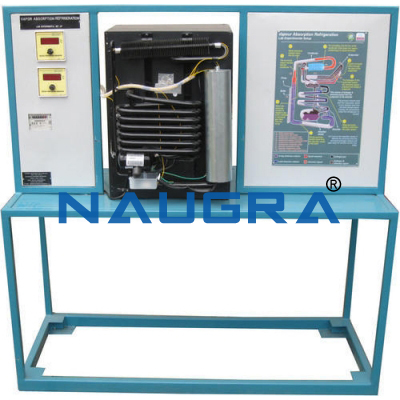- Workshop Tools and Workshop Machines India: buy@naugra.com

Absorption Refrigeration System .
Description of Absorption refrigeration systems for Science Lab Equipment Laboratory Instruments Manufacturers, Engineering Lab Equipments Manufacturers
Absorption refrigeration systems operate using thermal energy. They use the principle of liquids evaporating already at low temperatures when pressure is reduced. This basic principle is demonstrated in the experimental unit with the example of an ammonia-water solution with the ammonia acting as refrigerant.
In the evaporator the liquid ammonia evaporates and withdraws heat from the environment. To keep the evaporation pressure low, the ammonia steam in the absorber is absorbed by the water. In the next step, ammonia is permanently removed from the high concentration ammonia solution to prevent the absorption process from being halted. For this purpose, the high concentration ammonia solution is heated in a generator until the ammonia evaporates again. In the final step, the ammonia steam is cooled in the condenser to the base level, condenses and is returned to the evaporator. The low concentration ammonia solution flows back to the absorber. To maintain the pressure differences in the system, hydrogen is used as an auxiliary gas.
Specification of Absorption refrigeration systems:
Operation of an absorption refrigeration system
Main system components: evaporator, absorber, boiler with bubble pump, condenser
Ammonia-water solution as working medium, hydrogen as auxiliary gas
Boiler to separate ammonia
Bubble pump for transportation in the circuit
Adjustable electrical heater at the evaporator serves as cooling load
Boiler Is Alternatively Heated By Electrical Heater Or Gas Burner
Piezoelectric igniter for gas operation
Digital displays for temperature and power
